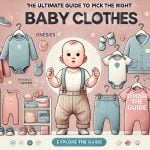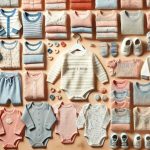Despite being tiny and small, it’s not uncommon to struggle yourself in a clutter of baby clothing. You obviously don’t want to keep groping all the laundry during rush hour or midnight sleep. It’s because parents need almost immediate clothing changes for the baby in many situations.
Proper organization of infant clothes is like everyday laundry, except for some exclusive benefits. It all starts with appropriate folding and accessible storage for minimalist wearables. However, practical folding strategies for different clothes are different for individual baby cloth types.
Benefits of Folding Your Baby Clothes
The task may seem somewhat daunting, given the quantity of laundry with baby wearables. But folding the items surely makes the entire process worthwhile with some crucial positives –
- No Messy Pileup – It’s incredibly easy to mess up everything with too much clothing. But rightful folding saves the entire hassle by keeping your storage free of pileups or messes.
- Optimized Storage Space – Clothes for a baby, even in the pint-sized versions, can consume a lot of space. An efficient folding allows parents/nannies to maximize the storage while everything is tidy.
- Steady Accessibility – Neat folding enables quick and easy locating of items without desperate searches. Dressing the little one becomes a breeze, particularly during diaper-changing emergencies.
- Prolonged Cloth Life – Careful folding of baby clothes helps prevent wrinkles on the soft fabric. So you don’t have to put the lightweight fabric under a hot iron more frequently.
Organizing Methods for Baby Clothes
Folding is more like an artful play with clothes. And there are different ways to fold the baby clothes. The ultimate three methods, preferred all over the world by parents, feature the following –
- Traditional: It’s the style to emphasize the odd corners, making them look like rectangles (favourably squares). The universal folding method is easy to adopt and employ, regardless of the laundry.
- KonMari: Turning the clothes into small parcels, capable of standing on the ends, sums up the KonMari. The somewhat recent but increasingly popular method lets you check all the options at once.
- Rolling: Folding the wearables into prolonged or extended lines for rolling is the third way. Like KonMari, you can see everything at once by packing the clothes unstacked yet organized in the drawer.

The primary difference between the three lies in the visibility of the stacking patterns. Traditional stacks require parents to check every item, whereas the other two maintain full visibility for all.
Folding a Onesie
You can fold a onesie in the standard KonMari method through the following steps –
- Place the item on a flat surface to soothe out the creases.
- Fold it in half in the vertical direction, from sleeve to sleeve.
- Now fold in the arms to put them directly on top of the body.
- Fold the body in half the horizontal, from buttons to collar.
- Again, fold the item in half horizontally to make it in a fourth.
However, there’s another technique (roll-up) with somewhat complex actions –
- Leave the bottom open, and lay the right side up on a surface.
- Bring the sleeves towards the collar without touching the cover.
- Now roll the piece from its top down until the bottom opening.
- Take both sides of the roll to bring them towards the centre.
- Grab the unrolled opening area to wrap the folding remainder.
- Fold down tabs and close them by binding the buttons to bases.
Folding a Sleeper
Put away the baby’s sleeper into storage after employing the following –
- Lay the piece face-down on a smooth surface.
- Gently soothe out all the creases on the fabric.
- Fold it vertically, sleeve to sleeve and leg to leg.
- Fold the arms to make them lay flat on the top.
- Fold the sleeper in a horizontal half, feet to collar.
- Again, fold it in half horizontally when possible.

Image Source: Upslash
Try to do thirds or roll-ups for thick sleepers (fleece for winter applications).
Folding a Pant
You can organize shorts and/or pants through tucks or KonMari. Experts recommend the tuck method so that you can access the item instantly. It features the following steps –
- Place baby pants on a flat surface.
- Make sure to soothe out all creases.
- Fold in half vertically, from leg to leg.
- Just fold ankles up, similar to cuffing.
- Fold it down two times for a lineup.
- Start the lineup from the other end.
- Tuck the edge into top ankle opening.
The KonMari approach may seem easier with fewer steps involved in folding –
- Lay the pants on flat surfaces to soothe creases.
- Fold the cloth in half vertically, from leg to leg.
- Now fold it in half horizontally, ankle to waist.
- Fold the piece in half horizontally for a fourth.
Please Not that you can fold baby shirts/t-shirts through tucking. And filing pants into drawers is the same, whether you use Tuck, KonMari, or both.
Folding a Pajama
Pyjamas aren’t the same as pants or shorts, requiring slightly deviated folding actions –
- Close the zipper and/or tie the buttons to lay them on a tabletop.
- Now, fold the pyjamas in half by putting both feet towards the collar.
- Fold both sleeves by placing them towards the pyjama centre.
- Now fold the item in half from top to bottom, then from left to right.
Folding a Jumpsuit
Jumpsuit resembles onesies and therefore, the folding is considerably similar. Of course, there are slight variations in the process, as mentioned below –
- Put the suit in its upside-down direction on a flat surface.
- Fold the hood down towards the centre (for hooded suits).
- Now fold the legs to make them indicate upward directions.
- Fold both sleeves inward while pulling a small part inward.
- Do fold the suit in double times from its bottom to the top.
Folding a Sock Pair
Try to avoid leaving the socks untouched in a bowl. It significantly hampers the elasticity as well as the lifespan. A comprehensive approach to extend their service lives could use –
- Keep the socks flat with heels folded over socks.
- Now lay either piece of sock on top of each other.
- Fold the top piece two times, starting with bottom.
- Put the folded one right on the other piece’s heel.
- Fold second sock to keep the first wrapped within.
Inserting the toe ends of the first sock into the opening of the other makes it ingenious in style. This envelope-like trapping should hold the pair together for quick or hurried grabbing.
However, not all sock types and/or parents can accommodate such a complex technique. In that case, do your usual double-fold and stack the pair together (on the top or side of pileups).
Folding a Romper
Hanging dresses and rompers are the ideal storage solution. However, you may need to fold such items temporarily or even permanently in certain conditions.

All you should do is fold the clothing in half in the vertical direction. You can further narrow down the size by double-time by a second time folding in half.
Folding a Hooded Towel
Messing up the hooded towel is easy for many first-timers during and even after storage. Help yourself with the following guide on a nice and neat folding –
- Place the towel on flat surfaces to spread the entire piece.
- Fold it in half vertically while aligning it with the towel’s bottom.
- Keep the hood still and out to fold it in half vertically again.
- Bring one-third towards the middle to fold the last third over.
- Just fold the kept-out hood over to finish the towel’s folding.
Hanging the Baby’s Clothes
As already mentioned, you better leave rompers ad dresses hanging in the closet. Some baby clothes, especially the “special occasion” clothes, shouldn’t be folded. Folding like regular wearables will cause tough-to-treat or even irreparable wrinkles.

Outerwear for babies (like – jackets or coats) features another clothing category to favor hanging. It’s common to develop a sense regarding which to put in a drawer and which ones to leave hung up. And you’ll need little hangers suitable for such items.
Storing the Folded Clothes
Appropriate storage facility for baby clothes is an obligatory nursing necessity. Always keep the daily essentials accessible for instant and effortless grabbing. Some nice suggestions would include –
- Bonnet Stand: Wearables like bonnets or hats come with different choices. Put them on display with bonnet stands by DIYing them with a candlestick and glass vase.
- Closet Divider: A closet divider is a specific drawer to accommodate next-size-up clothes. It offers an effective way to store clothes that your baby will grow into.
- Transparent Bin: Storage or organization of baby boy clothes gets simpler with transparent bowls. Clarity isn’t necessary for no-style items like socks, bibs, or towels.
- Outgrown Bin: Get a box inside the baby’s closet to toss outgrown items. Though it’s more suited for parents done having babies, it’s still helpful in many cases.
Parent barely look into gender-driven clothes. Obviously, taking your baby girl requires some exclusive outfits on events/occasions. Check out PatPat’s baby girl clothes to resemble her special presence.
Wrapping Up
Parenting a new baby can barely give time to think about folding the basic upbringing chores. And many don’t even know or emphasize the science of keeping everything organized. We don’t blame you since you can still manage the laundry while attending to all the primary tasks.
















Leave a Reply